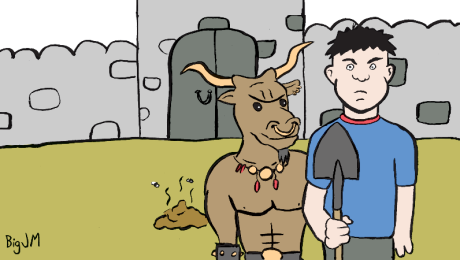Not only has he kept Morale through the editions, he's tacked on some neat mechanics for breaking Morale, which I will attempt to GLOGify here.
| Pictured: A Morale Penalty |
Morale Conditions
Morale breaking can take several forms. These are (quoting from the article):
Panic: Panicked creatures have lost their minds with fear. They drop their weapons – if they have any – and run as far and as fast as they can. Heedless of opportunity attacks, mind you.
Rout: Routed creatures don’t drop their weapons and flee. They withdraw and then move away. But they don’t care about their allies.
Retreat: Retreating creatures behave the same way, but they do care about their allies. They will call for a retreat and try to withdraw with their allies in good order. More importantly, if retreating creatures are cut off from escape, they will go back to fighting.
Surrender: Panicked and routed creatures will surrender if cornered. They make it clear that they don’t want to fight anymore and they are relying on their enemies to let them live. This usually leads to some kind of social interaction after the fight is over. Obviously, this option is reserved for lawful creatures who think they can rely on their enemies – the heroes – to respect the rules of engagement and behave in an honorable fashion.
Rage: When their morale breaks, they keep fighting. But they don’t recognize their allies as allies. That doesn’t mean they turn on their allies. But it does mean that things that affect allies or key off of having allies don’t work anymore. And, if they find themselves without a target for their rage, they will attack the closest creature. Former friend or foe. Basically, they’ve gone berserk.
Betray: They actually start fighting their allies. They don’t consider the PCs allies – though they might make friends in some interaction at the end – but they don’t consider their allies allies anymore and they attack their allies, ignoring the PCs. This is generally reserved for opportunistic mercenaries and sellswords who think the PCs will reward them for their betrayal. And it is also for summoned elementals, demons, golems, and other enslaved creatures – magically enslaved or just abused and brutally mistreated – who will turn on their masters if their morale breaks and control is lost.
A bit wordy at the end, but words can be fiddly. The concepts themselves are distinct, easy to remember, and offer more opportunities in and out of combat.
 |
| Pictured: Rage |
We can split these into five reactions to breaking morale, with Surrender as a special condition of Panic or Rout if there is no room to escape.
Under LotFP, GLOG and adjacent rules, creatures have a morale from 2-12, which one rolls against with 2d6. Roll under, you succeed, roll over, you fail.
Which means we can assign different outcomes to varying degrees of failure.
Spitballing, let's say that failing Morale by 2 or less results in a Retreat, by 3-4 a Rout, and by 5+ a Panic. Using this, enemies with high Morale (8+) will not only be more likely to keep fighting, but will prefer to retreat, rarely routing and never panicking.
But where, then, do Rage and Betray come in?
The above fits more Lawful types, whereas Rage and Betray fit more Chaotic types. Even if you don't use alignment (I don't) or prefer the Good/Evil axis, I'm sure you can see the difference.
For enemies like guards and ant-lings, the tree goes Retreat -> Rout -> Panic.
For enemies like goblins and desperate sellswords, it goes Retreat -> Rage -> Betray.
This is, of course, easy to modify on the fly. Angry proposes that just one of these be used at a time, e.g. Wisdom Save DC ## or (Effect). This fits enemies for which one reaction is iconic or especially likely. A berserker is going to rage, a cowardly goblin is going to panic, a two-faced rogue is going to betray their side, etc.
Being GM-faced, you can use the trees for a more granular approach, and mark specific enemies with single reactions at will. Customize those trees to your liking and plug it right into your game. It's quick, easy and I'll be sure to use it in my own games.
 |
| Read this guy's blog already! |
No comments:
Post a Comment